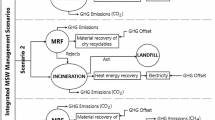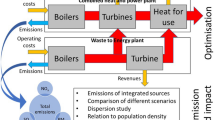Abstract
In this study, there were 54 municipal solid waste (MSW) moving-grate incineration power plants investigated in China. The flue gas emission data of CO, NOx, SO2, HCl, and particles were collected as monthly means directly from the plants for 12 consecutive months from 2011 to 2012, as well as the annual cumulative consumption data of activated carbon, CaO/Ca(OH)2, and #0 diesel. Eventually, 37 out of the 54 plants were evaluated on the overall performance using the Mahalanobis distance. As a result, there were 31 total outliers (potential errors or risks in the operation) detected from the flue gas emission data in 9 out of 37 plants. The results revealed that the Mahalanobis distance was an effective method to evaluate the overall performance of MSW moving-gate incineration from the massive normal-looking flue gas emission data. It was also illustrated that reducing the frequency of the load changes was more important than reducing the magnitude of the load changes, especially in the range between − 10 and 10% of the load changes. Furthermore, the average consumption of activated carbon, CaO/Ca(OH)2, and #0 diesel in the MSW moving-grate incineration power plants was 0.32 ± 0.13 kg, 7.75 ± 3.06 kg, and 0.15 ± 0.12 kg per ton of MSW, respectively.



Similar content being viewed by others
References
Anderson, S. R., Kadirkamanathan, V., Chipperfield, A., Sharifi, V., & Swithenbank, J. (2005). Multi-objective optimization of operational variables in a waste incineration plant. Computers & Chemical Engineering, 29(5), 1121–1130.
Ben-Gal, I. (2005). Outlier detection. In O. Maimon & L. Rockach (Eds.), Data mining and knowledge discovery handbook: a complete guide for practitioners and researchers (pp. 1–16). New York: Kluwer Academic Publishers.
Beylot, A., & Villeneuve, J. (2013). Environmental impacts of residual municipal solid waste incineration: a comparison of 110 French incinerators using a life cycle approach. Waste Management, 33(12), 2781–2788.
Cheng, H., & Hu, Y. (2010). Municipal solid waste (MSW) as a renewable source of energy: current and future practices in China. Bioresource Technology, 101(11), 3816–3824. https://doi.org/10.1016/j.biortech.2010.01.040.
De Greef, J., Villani, K., Goethals, J., Van Belle, H., Van Caneghem, J., & Vandecasteele, C. (2013). Optimising energy recovery and use of chemicals, resources and materials in modern waste-to-energy plants. Waste Management, 33(11), 2416–2424. https://doi.org/10.1016/j.wasman.2013.05.026.
Dvořák, R., Pařízek, T., Bébar, L., & Stehlík, P. (2008). Incineration and gasification technologies completed with up-to-date off-gas cleaning system for meeting environmental limits. Clean Technologies and Environmental Policy, 11(1), 95–105. https://doi.org/10.1007/s10098-008-0170-7.
Glorennec, P., Zmirou, D., & Bard, D. (2005). Public health benefits of compliance with current E.U. emissions standards for municipal waste incinerators: a health risk assessment with the CalTox multimedia exposure model. Environment International, 31(5), 693–701. https://doi.org/10.1016/j.envint.2004.12.004.
González-Arteaga, T., Alcantud, J. C. R., & de Andrés Calle, R. (2016). A cardinal dissensus measure based on the Mahalanobis distance. European Journal of Operational Research, 251(2), 575–585. https://doi.org/10.1016/j.ejor.2015.11.019.
Griffin, S. C., Taper, M. L., Hoffman, R., & Mills, L. S. (2010). Ranking Mahalanobis distance models for predictions of occupancy from presence-only data. Journal of Wildlife Management, 74(5), 1112–1121. https://doi.org/10.2193/2009-002.
Hsu, S.-H. (2006). NIMBY opposition and solid waste incinerator siting in democratizing Taiwan. The Social Science Journal, 43(3), 453–459.
Huang, Y., Ning, Y., Zhang, T., & Fei, Y. (2015). Public acceptance of waste incineration power plants in China: comparative case studies. Habitat International, 47, 11–19.
Hung, P. C., Chang, S. H., Buekens, A., & Chang, M. B. (2016). Continuous sampling of MSWI dioxins. Chemosphere, 145, 119–124. https://doi.org/10.1016/j.chemosphere.2015.11.111.
Lehmann, R. (2015). A new approach for assessing the state of environment using isometric log-ratio transformation and outlier detection for computation of mean PCDD/F patterns in biota. Environmental Monitoring and Assessment, 187(1), 4149. https://doi.org/10.1007/s10661-014-4149-z.
Li, Y., Zhao, X., Li, Y., & Li, X. (2015). Waste incineration industry and development policies in China. Waste Management, 46, 234–241.
Li, Z., Filev, D. P., Kolmanovsky, I., Atkins, E., & Lu, J. (2017). A new clustering algorithm for processing GPS-based road anomaly reports with a Mahalanobis distance. IEEE Transactions on Intelligent Transportation Systems, 18(7), 1980–1988. https://doi.org/10.1109/tits.2016.2614350.
Liu, Z., Liu, Z., & Li, X. (2006). Status and prospect of the application of municipal solid waste incineration in China. Applied Thermal Engineering, 26, 1193–1197. https://doi.org/10.1016/j.applthermaleng.2005.07.036.
Mahmoud, S., Lotfi, A., & Langensiepen, C. (2016). User activities outliers detection; integration of statistical and computational intelligence techniques. Computational Intelligence, 32(1), 49–71.
Mei, J., Liu, M., Wang, Y. F., & Gao, H. (2016). Learning a Mahalanobis distance-based dynamic time warping measure for multivariate time series classification. IEEE Transactions on Cybernetics, 46(6), 1363–1374. https://doi.org/10.1109/TCYB.2015.2426723.
MEP (Ministry of Environmental Protection of China), & AQSIQ (General Administration of Quality Supervision, Inspection and Quarantine of China). (2001). Standard for pollution control on the municipal solid waste incineration (GB 18485-2001). Beijing: Standards Press of China.
MEP (Ministry of Environmental Protection of China), & AQSIQ (General Administration of Quality Supervision, Inspection and Quarantine of China) (2014). Standard for pollution control on the municipal solid waste incineration (GB 18485-2014). http://kjs.mep.gov.cn/hjbhbz/bzwb/gthw/gtfwwrkzbz/201405/W020140530531389708182.pdf. Accessed 13 Apr 2016.
MOHURD (Ministry of Housing and Urban-rural Development of China). (2010). Standard for assessment on municipal solid waste incineration plant (CJJ/T 137-2010). Beijing: China Architecture and Building Press.
MOHURD (Ministry of Housing and Urban-rural Development of China). (2013). China urban construction statistical yearbook 2012. Beijing: China Statistics Press.
Nie, Y. (2008). Development and prospects of municipal solid waste (MSW) incineration in China. Frontiers of Environmental Science & Engineering in China, 2(1), 1–7. https://doi.org/10.1007/s11783-008-0028-6.
NPC (National People’s Congress of China). (2003). NPC standing committee inspecting enforcement report on the law of environmental pollution prevention caused by solid waste. http://www.npc.gov.cn/wxzl/gongbao/2003-08/12/content_5318892.htm. Accessed 10 May 2016.
Perkoulidis, G., Papageorgiou, A., Karagiannidis, A., & Kalogirou, S. (2010). Integrated assessment of a new waste-to-energy facility in Central Greece in the context of regional perspectives. Waste Management, 30, 1395–1406. https://doi.org/10.1016/j.wasman.2009.11.021.
Sarraf, A. P. (2015). Flood outlier detection using PCA and effect of how to deal with them in regional flood frequency analysis via L-moment method. Water Resources, 42(4), 448–459.
Somplak, R., Ferdan, T., Pavlas, M., & Popela, P. (2013). Waste-to-energy facility planning under uncertain circumstances. Applied Thermal Engineering, 61(1), 106–114.
Tao, H., He, P., Zhang, Y., & Sun, W. (2017). Performance evaluation of circulating fluidized bed incineration of municipal solid waste by multivariate outlier detection in China. Frontiers of Environmental Science & Engineering, 11(6), 4. https://doi.org/10.1007/s11783-017-0945-3.
Wang, D., Wang, Q., Wang, H., & Zhu, H. (2016). Experimental study on damage detection in timber specimens based on an electromechanical impedance technique and RMSD-based Mahalanobis distance. Sensors, 16, 1765. https://doi.org/10.3390/s16101765.
Wicklin, R. (2012). What is Mahalanobis distance? https://blogs.sas.com/content/iml/2012/02/15/what-is-mahalanobis-distance.html. Accessed 28 Feb 2018.
Wright, C., & Booth, D. (2001). Water treatment control using the joint estimation outlier detection method. Environmental Modeling and Assessment, 6, 77–82.
Yi, S., Yoo, K. Y., & Hanaki, K. (2011). Characteristics of MSW and heat energy recovery between residential and commercial areas in Seoul. Waste Management, 31(3), 595–602. https://doi.org/10.1016/j.wasman.2010.09.008.
Zheng, L., Song, J., Li, C., Gao, Y., Geng, P., Qu, B., & Lin, L. (2014). Preferential policies promote municipal solid waste (MSW) to energy in China: current status and prospects. Renewable and Sustainable Energy Reviews, 36, 135–148. https://doi.org/10.1016/j.rser.2014.04.049.
Zhou, Y.-L., Figueiredo, E., Maia, N., Sampaio, R., & Perera, R. (2015). Damage detection in structures using a transmissibility-based Mahalanobis distance. Structural Control and Health Monitoring, 22(10), 1209–1222. https://doi.org/10.1002/stc.1743.
Acknowledgments
The authors sincerely appreciate the Chinese colleagues, members of the China Association of Urban Environmental Sanitation, and Tian Yu for offering the data and assistance for this study.
Author information
Authors and Affiliations
Corresponding author
Rights and permissions
About this article
Cite this article
Tao, H., He, P., Wang, Z. et al. Application of the Mahalanobis distance on evaluating the overall performance of moving-grate incineration of municipal solid waste. Environ Monit Assess 190, 284 (2018). https://doi.org/10.1007/s10661-018-6653-z
Received:
Accepted:
Published:
DOI: https://doi.org/10.1007/s10661-018-6653-z




